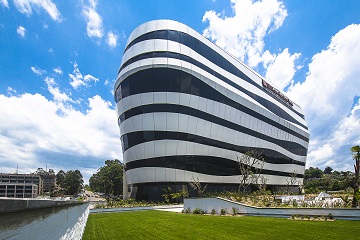
One major focus in 2019 for architecture
and interior architecture group Paragon remains the acquisition and
implementation of architecture and interior design projects in Africa, with
another one being the growth of the newly-established Cape Town office, according
to Director Henning Rasmuss.
Major successes in Africa in 2018 included the ongoing
construction of The Habitat residential tower in Nairobi. At 23 storeys, this
is Paragon’s tallest building in construction to date. Also in Nairobi, the
group is close to construction completion on the 24 000 m2 Crystal
Rivers Mall, which Rasmuss describes as “an unbelievably challenging project.”
Significant new project successes include residential
and commercial projects in Swaziland. Also in Swaziland, the 160-room Hilton
Garden Inn Hotel, already a landmark on the Mbabane skyline, is approaching
completion. A groundbreaking ceremony for the Pullman Airport City hotel and
apartment project, attended by Ghana President Nana Akufo-Addo, took place just before Christmas
2018.
Paragon also bid for the Orange Data Centre in
Botswana. Data centre projects are one specialist practice area, with the
company having a ten-year track record in their design.
Interior design highlights in 2018 included being appointed
for the South African roll-out of projects for a major global shared workspace
provider, and smaller ongoing corporate fit-out projects in Tanzania and Nigeria.
“Africa is bigger than the US, Europe, and China
combined. We often forget how big it is as a continent. There is great
architecture being realised throughout Africa. We just need to be sensitive and
responsive to the local environment, skills, and available materials,” Paragon
Group Director Anthony Orelowitz comments.
The major challenge faced by the Group and the
architecture and construction sectors in particular last year was the continued
erosion of business confidence in the South African economy leading to project
postponements, and to a tough and relentlessly aggressive procurement culture.
“Being a large company with experience and cash
reserves, we are able to manage these challenges, but smaller and emerging
companies are being forced out of the market, and the trading environment is
dismal especially for small and black-owned companies,” Rasmuss stresses.
Looking to 2019, there are a larger number of smaller
projects in South Africa, and outside its borders. “We see a strong upsurge in interior
design and fit-out projects. This is an ongoing trend where we are positioned favourably
through strong partnerships,” Rasmuss notes.
One of the early adopters of Revit 3D design software,
the Paragon Group has since branched out further. “We are now using augmented
reality and virtual reality to help understand our building designs better, and
to allow our clients to experience the actual spaces before they are built. We
are using a lot of 3D printing to make components that we cannot manufacture
using traditional methods, such as The Link in Rosebank, where the internal
form-making is cutting-edge on a global level,” Orelowitz concludes.
Connect with Paragon on
Facebook: https://www.facebook.com/ParagonGroupZA
LinkedIn: http://bit.ly/ParagonGroupLinkedIn
Instagram: paragongroupza
More news
- PART 2: CONCRETE IN THE DESIGN OF A UNIQUE LUXURY HOME IN GEORGE, SOUTH AFRICA
- PART 1: CONCRETE IN THE DESIGN OF A UNIQUE LUXURY HOME IN GEORGE, SOUTH AFRICA
- MVULE GARDENS, AFRICA’S LARGEST 3D-PRINTED AFFORDABLE HOUSING PROJECT
- PART 3: HARNESSING THE POTENTIAL OF HIGH SULPHUR FLY ASH IN CONCRETE PRODUCTION
- PART 2: HARNESSING THE POTENTIAL OF HIGH SULPHUR FLY ASH IN CONCRETE PRODUCTION

